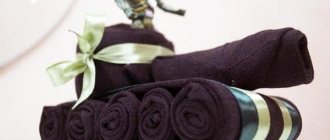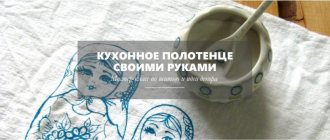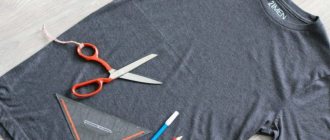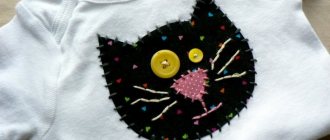Despite the fact that modern trends encourage women to dress in bright and extraordinary looks, some representatives of the fair sex want to dress in things that emphasize their femininity and focus on tenderness and elegance. This is the type of clothing that can attract the attention of men. In recent years, dresses and blouses called “Peasant Young Lady” have been gaining popularity.
The style of the products has remained unchanged for hundreds of years and emphasizes all the advantages of the figure and hides flaws. You can make such a dress yourself. This material will tell you what a peasant blouse is, a pattern for a peasant dress with a sleeve, and what is needed for this.
Classic styles “Peasant Young Lady”
History of creation
This product was first produced in the 18th century. The new style was more comfortable to wear and practical. It was because of this that he began to gain popularity not only among ordinary peasant women, but also noble gentlemen. At the peak of popularity, many began to sew their own outfits. This was made mainly from cotton and linen fabric.
Scheme of the most basic dress of 4 parts
The first type of style had the following qualities:
- focusing on the waist;
- open shoulders;
- puffy sleeves;
- wide skirt.
Important! Rich people who were accustomed to luxury decorated the product with expensive materials: stones, gold threads, lace and so on.
The product in question is a cream color
DIY peasant blouse
Along with extraordinary, bright and literally flashy images, young ladies are increasingly looking for clothing options that would more accentuate the tenderness and femininity of a girl’s nature.
As practice shows, it is precisely these outfits that make it possible to attract more male attention and the inquisitive glances of girls to your person. Recently, dresses and blouses called “Peasant Young Lady” have begun to gain popularity.
This style has remained relevant for several hundred years. It is not surprising, because such a piece of clothing emphasizes all the advantages of a girl’s figure, making her silhouette very slender. Every year, designers improve it more and more, making the item of clothing more attractive and sophisticated.
In this article we will tell you how to sew a dress yourself, what a peasant blouse can look like with your own hands, and give some tips on wearing them.
History of creation
For the first time in history, such a dress appeared in the 18th century. Remember the paintings of that time: most young ladies are depicted in long and fluffy dresses. Imagine how original a girl in a modest and simple dress would look against their background.
The dress style, which had just been invented at that time, turned out to be more comfortable than dresses with corsets and fluffy hemlines, as a result of which it soon gained a large number of fans, among whom were noble ladies. As soon as such attire came into fashion, women began to sew their own peasant dresses from thin cotton fabric. They wore several layers of underwear under their clothes.
The first styles had the following qualities:
- The item of clothing focused attention on the girl’s waist.
- Women's shoulders were always open.
- The sleeves were quite puffy.
- The skirt was wide. Due to this factor, the waist stood out even more clearly.
Product advantages today
This item was in demand not only in ancient times. Today, a blouse or peasant dress can be an original addition to a summer wardrobe. The advantages lie in the comfort and lightness of the product, and the refinement of its lines. Moreover, the sewing process itself is quite exciting.
Printed fabric item with long hem
Advantages of the style
The product will create an image of femininity and original simplicity. Against the background of newfangled short dresses that barely cover the buttocks, a peasant dress will seem something new and original, but at the same time unusually simple. Modern design provides products with a large number of different decorative elements and sleeve shapes.
You may be interested in this Guide to setting up, adjusting and repairing the Chaika sewing machine
Sleeve decoration
Fascinating process
The process of sewing such a product is very exciting, since it does not require serious knowledge of sewing and cutting, and it brings a lot of pleasure. By sewing blouses of this type, you can get a good handle on more complex things.
Neck decoration
Refinement of lines
Compared to other modern dresses, the “Peasant Woman” model, thanks to its style, has a special property that can make the lines of the figure thinner, shift the emphasis to a beautiful chest or thin waist.
Light summer dress with open shoulders
Comfort and ease
This product will never restrict body movement, because it does not hug the body and sits freely. You won't feel hot in a dress or blouse even on the hottest days of summer. All thanks to natural materials.
Model with closed shoulders
How to choose the right style?
A floor-length peasant dress is considered a classic of the genre. This is the most common model among designers, and this is where it all began. Later, shortened versions appeared to the knee and above. The upper part of the product may have draperies, embossing, embroidery or frills.
Despite the fact that a dress in the “peasant lady” style is suitable for ladies of any age and with any body type, it must be chosen correctly. So, if there is a need to hide your stomach and hips, then it is better to choose a dress with a full skirt and a wide belt that will emphasize the waist, and everything else will be hidden from prying eyes. If you need to give your breasts fullness, an elegant neckline will help.
Young ladies with wide and massive shoulders are not advised to buy a dress with completely open shoulders, as this will emphasize them even more.
The highlight of the robe can be a slit (for example, on the side) - this is for those who have slender legs, as they will be visible while walking. According to stylists, it is worth choosing shoes with heels to complement the cut in order to visually lengthen your legs.
Material selection
At one time, only natural fabrics such as cotton or linen were used. The advantage today must be given to them. Today, other materials are also used for sewing dresses: wool, jacquard. Chintz, chiffon, poplin, silk or staple fit and look great. Light cambric can also allow you to create unique models.
Linen is an excellent choice for this type of product
Important! You can also use simple knitwear of absolutely any density and quality. The only limitation is that the knitwear has a little stretch.
Sewing will most likely require 2 to 6 meters of fabric. It all depends on the length of the product and the length of the sleeves. That is why before manufacturing it is necessary to accurately measure the amount of material required.
Raglan Peasant Dress
White blouse - simple!
- Hello, friends!
- Surely, you know the blouse model discussed below.
- This is a peasant-style blouse that even novice tailors can sew.
- Moreover, the style suits almost any woman , and the white color, depending on the shade, only refreshes the owner of the item.
- Wear a blouse with a flowy skirt if you are a fan of a romantic style, or pair it with regular jeans if you like sportswear.
- Whatever you choose, such a blouse will not leave anyone indifferent!
Modeling options
fabric for a summer blouse in a peasant style that is natural or contains natural fibers, breathable, comfortable to wear and draped in soft folds.
Cotton, cambric, bleached linen poplin, light viscose fabrics, etc. are ideal.
Before cutting, take the necessary measurements:
- chest girth 3 (Og3),
- shoulder girth (Op),
- sleeve length (Dr),
- blouse length (Dizd).
Approximate sketch of the model
For the pattern, you can use the option suggested in the video or cut directly on the fabric as follows:
Draw four rectangles - back, front and sleeve details:
- For the back and front details, cut out rectangles with a width equal to ½ chest circumference plus 10-15 cm for a loose fit. The length is equal to the desired length of the blouse.
- For the sleeves, cut out rectangles, the length of which is the desired length of the sleeve, and the width is the girth of the arm plus 10-20 cm, depending on the desired freedom (plumpiness) of the sleeve.
Sewing a blouse in a peasant style:
- Fold the part in half with the right side inward, stitch, not reaching the end of the cut 10-15 cm. - a segment for the future armhole;
- Sew the seams;
- Also overcast the bottom of the sleeve and sew lace trim along the edge;
- Or finish the bottom with a hem/drawstring stitch;
- Processing options depend on model features and desire;
- Sew the side seams of the back and front parts, leaving 10-15 cm unsewn.
- Sew seams, press;
- Fold the sleeve pieces and the prepared back and front pieces right sides inward, along the unstitched areas.
- Chip/sweep the pieces;
- Stitch the cuts;
- Sew the seams.
- Overcast the neckline;
- Baste the neckline seam allowance to the wrong side;
- Sew close to the edge (0.2 -0.5 cm)
- Sew lace along the edge.
For a better fit on the figure, sew an elastic band (elastic band) along the neckline, for this:
- Place it on the wrong side of the blouse;
- Sew a narrow zigzag stitch along the top of the braid;
Instead of an elastic band, you can make a drawstring from a strip of fabric and insert thin ties or braid into it.
- Overcast the hem allowance, iron it to the wrong side, pin or baste;
- Stitch close to the edge on your sewing machine.
- The bottom can also be decorated with lace braid.
- The blouse is ready.
- For another option on how to sew a blouse in a peasant style , see the video below:
- Everything for sewing, needlework and creativity - CLICK
- How to sew a blouse in 5 minutes, see here
- With wishes of good luck, Elena Krasovskaya https://shjem-krasivo.ru/
Source: https://shjem-krasivo.ru/novoe/bluza-v-krestyanskom-stile.html
Layout and fabric consumption
There are two options for cutting and laying out fabric:
- If the width is 80 centimeters: two lengths of a shirt or dress + sleeve lengths. The seams in this case will be side;
- If the width is 140 - 150 centimeters: one shirt or dress length + sleeve length. There is only one seam: along the back or front.
Printed cambric is in no way inferior to cotton and linen
Blouse patterns for obese women
Girls with curvy figures should not wear shapeless clothes. A fitted cut of clothing will visually slim your figure. The loose style of things will give comfort when moving.
Today we will tell you what you can sew for girls who find it very difficult to choose clothes.
Girls with a non-standard figure should definitely have office blouses in their wardrobe. The practicality of such clothing is known to everyone. Fitted blouses can be combined with any clothing: straight skirt, trousers and jeans.
An example of a blouse pattern can be seen in the photo. The style is a blouse with a yoke, with long sleeves.
The next model is sewn based on a dress pattern for plus size girls. A short-sleeved blouse is an excellent solution for work and everyday meetings. The length of the blouse can be chosen at your discretion.
The one-piece sleeve reduces the time required to sew a blouse. The sleeves and hem are hemmed with a closed hem. The neck is processed by facing.
A loose blouse with a drawstring will definitely appeal to those women who prefer a loose style. The V-shaped neckline and beautiful tails of one-piece sleeves will add zest to any girl’s look.
A seductive top with straps will allow girls to wear their favorite jewelry. To sew such a stunning top, a ready-made sundress pattern will do. The length on the pattern is adjustable to your liking.
The photo shows that the yoke is cut from a different fabric that matches the color. A combined top made of two materials will look simply amazing.
A polka dot tunic blouse is cut out in 2 parts: a back and front with a one-piece sleeve. The waist is gathered with elastic. The style of the blouse allows you to combine it with narrow trousers.
You can choose any material for all of the listed blouses: silk, chiffon, satin, cotton. A satin blouse is suitable for special occasions and holidays. Silk, chiffon - if the blouse is intended for birthday celebrations, work and school.
Office work involves spending a long time in stuffy offices. Silk and chiffon blouses will be a real lifesaver. The fabrics are breathable and dry quickly.
Tunic is a universal model for all women. The style of the blouse with a dropped shoulder, one-piece sleeves and a v-neck are three advantages of sewing such a tunic for yourself.
The drawing is made using a ruler and pencil on paper. The pattern is suitable for beginners in sewing.
The neckline and bottom of the sleeves can be finished with a facing or any bias tape. Contrasting bias tape will give the product a beautiful look. This version of the binding is suitable if the main fabric is plain or the color of the binding matches one of the colors on the fabric.
Summer beckons with its heat. And more and more short-sleeved clothes are appearing in women's wardrobes.
Cutting does not require great sewing skills. The absence of darts is another opportunity to try yourself as a skilled seamstress. The style of the blouse will visually remove excess from the figure.
Where does the creation of a sleeveless blouse begin? Below are detailed instructions:
- Create a pattern drawing on paper, outline the main outline of the pattern with a thick line and cut it out.
- Separately on paper, redraw the neckline and armhole and make a facing pattern. The width of the facing is 3 cm.
- Fold the fabric in half along the grain. Pin the back and front pattern with pins so that the middle of the fabric coincides with the middle of the front and back. Trace the pattern with a simple pencil along the outline. Next, you need to set aside seam allowances from the outline. Cut out the cut details.
- Cut the facing onto the fabric. If there is not enough material, then the facing is cut out in parts. In this case, all parts must be sewn.
- A zipper should be sewn into the middle of the back. Make a cut in the back piece for the length of the zipper (see video). Finish open sections with a zigzag stitch or a special stitch for overcasting.
- Baste and sew the sides of the blouse and shoulders.
- Finish the neckline and two armholes with a facing.
- Hem the bottom of the product
Peasant blouse pattern and sewing master class
“Peasant Woman”, like no other dress, is suitable for the summer heat, because it is made from natural fabrics. This ensures good heat exchange and allows moisture to evaporate quickly.
Dress with drawstrings and elastic bands
The first step is to create patterns, and to do this, take the following measurements:
- Shoulder width. Measured horizontally from one extreme protruding point of the shoulder to the other;
- Chest circumference. The centimeter should pass along the most protruding points of the chest parallel to the floor;
- Waist circumference. Produced at the narrowest point;
- The length of the dress is from the armpit, because it will hang on the shoulders;
- Sleeve length: from the end of the shoulder to a predetermined length;
- The circumference of the arm, or rather the widest part of it. It is best to take the widest part of the forearm;
- The circumference of the narrowest part of the hand is the wrist.
You might be interested in how to sew a beautiful fabric flower yourself as a decoration on a dress
Natural material is an excellent choice for baby clothes
The front and back are made as follows:
- The bottom is measured, the length of which is equal to 75% of the chest circumference;
- A line is drawn that will be perpendicular to the top for the entire length of the product from the armpits + 10 cm + 15 cm;
- 11 cm is deposited from the top and another 15 cm from it at an angle of 45 degrees;
- Also, 10 cm is set aside from the top. The narrowest horizontal width is measured.
Shirt dress, the style of which comes from an ancient product.
The sleeves are made like this:
- A measurement of the width of the entire dress along the bottom is taken and added to a quarter of this segment. Next, all measurements of the minimum width are subtracted and the resulting value is divided by two. This will be the width of the very top of the sleeve;
- This value is placed on the pattern and measured down 10 cm, as in the case of the back and front;
- 11 cm are laid off and a line is drawn at an angle of 45 degrees. A sleeve is drawn to a predetermined length so that its width is the same for all participants.
Peasant dress for girls
Next, the front, back and sleeves are cut out on the selected fabric, taking into account an allowance of 1 centimeter. Stitching is done on a machine along the lines that were previously drawn at an angle of 45 degrees. A neck drawstring is made at the top to insert elastic by bending the top into a double bend. After this, the sides of the front and back of each sleeve are sewn together. You can also make a drawstring for an elastic band on your hand if the length allows. You can leave it wide and loose for greater breathability.
Important! If desired, it is possible to attach ribbons, ribbons or floss instead of elastic bands. The product is decorated with embroidery in ethnic style, special fabric paints and many other things.
Peasant blouse
Here, look at how our pattern will roughly look like - all you need to do is model one part for the front/back, one part for the sleeves.
To create a pattern, we take only seven measurements. You can do all of them on yourself, I checked! 1) Product width across the shoulders 2) chest volume - full 3) product length from the armpit 4) waist volume - full (for elastic) 5) sleeve width at the wrist (for elastic) 6) sleeve width at the forearm
7) sleeve length from the shoulder (I will make the sleeve ¾)
The next stage is to design the pattern.
Front and back
3. Set aside 11 cm from the top border and draw a line at an angle of 45 degrees, line length 15 cm
4. Set aside another 10 cm and complete the pattern. It looks like a schematic drawing of a glass jar with a lid - this will be a drawing of the back and front. Measure the width of the highest back/front line.
We start designing the sleeve from the top
5. How to calculate the size of the sleeve head - take item 5 (the width of the product) + another quarter of this number (I got 138), from the resulting number we subtract two widths of the upper part of the front or back (item 4) and divide the remainder by two. The resulting number is the width of the uppermost part of the sleeve. 6. Put this number on the pattern, measure down 10 cm, as on the front/back. 7. Then, just like on the front/back, we set aside (this time down, since we are going from top to bottom) 11 cm and draw a line at an angle of 45 degrees. All that remains is to put it aside and draw the length of the sleeve. Check the resulting sleeve width - it should be no narrower than point 5 of your measurements. The pattern is ready! You can cut and start sewing. First, we sew the upper “oblique” parts of the parts, fold them in half, and make a drawstring for the collar. You can thread a ribbon, a homemade cord twisted from two multi-colored strands of floss or yarn into the drawstring, or simply insert an elastic band. Then we sew the side seams. The last stroke of the needle - we make a drawstring on the sleeves (if desired, you can leave the sleeves wide - this also has its own charm), pull the elastic into it, and hem the hem of the product. If desired and to taste, we decorate with embroidery, appliqués, and paint on fabric with paint or felt-tip pens. Here, in order to give an impetus to your inspiration, are several models sewn on the basis of the “peasant” model.
- What do you think of this option, with a wide frill at the top?
- Save so you don't lose.
- Source
Modern patterns for “young lady-peasant” dresses
This section contains a collection of top pattern patterns for a modern adapted dress and blouse of the “Peasant Young Lady” type. They will help inspire craftswomen to do something more and help inexperienced needlewomen in their work.
Quick pattern for a blouse “Peasant Woman”
Thus, sewing a blouse or dress of this kind will not be difficult even for novice seamstresses. Thanks to its simplicity and freedom, the same product can easily be worn by owners of sizes 42, 44, 48, 50, 54. This is the comfort and convenience of wearing such products.
You might be interested in this: We sew summer dresses with skirts: interesting patterns
Peasant woman blouse pattern – sewing a boho style blouse for the summer
Pattern of a peasant blouse with a straight silhouette and open shoulders. We present to your attention a master class on sewing a fashionable blouse with photos and descriptions.
Hot summer days are just around the corner and the need to wear something completely light, airy and bright. What could better meet all these requirements than a cotton peasant blouse with a straight silhouette and open shoulders?
In this article we will tell you how even novice needlewomen can sew themselves a chic and fashionable blouse for the summer.
Peasant blouse - this style has a huge number of advantages
- It is fashionable and relevant, because these blouse styles are present in such clothing styles as shabby chic, gypsy, boho and country.
- Blouses in the “Peasant Woman” style fit perfectly into any style and are quite compatible even with some business-style sets.
- The loose fit, comfortable sleeve length and lightweight material (usually cotton or linen) make this blouse the #1 option for the summer.
In fact, the benefits of a peasant blouse can be listed almost endlessly. Modern fashionistas, as practical and busy people, know that it is better to check all this in practice.
Therefore, let’s move from words to this very action and tell you about how the pattern of the Peasant blouse is constructed. We will also explain to you how to sew a peasant blouse for beginners and experienced needlewomen.
Peasant blouse pattern - sewing a boho style blouse for the summer
We invite you to create a pattern and sew a peasant blouse, a master class on the manufacture of which was prepared by the magazine Burda/3/2017:
We invite you to create a pattern and sew a peasant blouse, a master class on the production of which was prepared by the magazine Burda/3/2017 We invite you to create a pattern and sew a peasant blouse, a master class on the production of which was prepared by the magazine Burda/3/2017
We also offer you a selection of current sets for the summer, the main character of which is the Peasant blouse.
Enjoy watching, get inspired and create your own style!
Peasant blouse - what to wear with it in 2022
A peasant blouse goes well with skirts (it can be a fairly strict pencil skirt and a fluffy flared bell skirt or a straight, colorful floor-length skirt). But the Peasant blouse looks no less great with trousers. Be it jeans, classic trousers or summer cropped capri pants and shorts.
A peasant blouse goes best with boho and gypsy style accessories:











